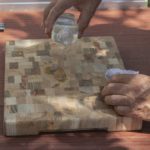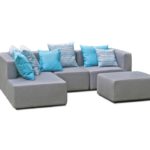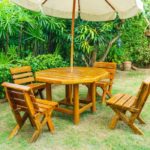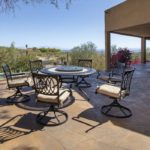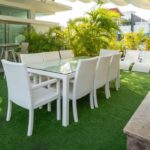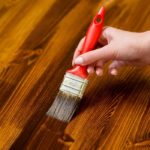There are many reasons you should have outdoor furniture – for relaxation, for parties and hangouts, and even improving the aesthetics of your home. We should all know that outdoor furniture is as essential as indoors, and that means you can’t afford to buy furniture made with inferior materials. So, what is the best material for outdoor furniture?
Some materials that are strong enough to endure outdoor conditions are: synthetic resin, teak, aluminum, steel, wrought iron, and recyclable plastic. Wood is a good go-to, while metal furniture will last longer. Cushions and umbrellas should be made from water-resistant fabrics.
Each of the materials mentioned above serves their purposes and has different characteristics that make them stand out in their own way. Let’s look at the pros and cons in more detail to find out how these materials fit into what you need for your outdoor furniture.
What is the Best Material to Use for Outdoor Furniture?

There’s no one-size-fits-all option when deciding the best material to use for outdoor furniture. There are different materials you can use for your outdoor furniture, and each of them come with their pros and cons.
That means no one can handpick any one material as the best above all others. It all depends on what you need as an individual in terms of aesthetics, durability, price, etc.
You also need to have an idea of some of the available materials available for outdoor materials and their pros and cons. This will inform your decision, and you can finally choose a more suitable material.
Although there are several materials you can choose from, some are way better than others. While we won’t tell you that any of them is the best, we will create a table outlining the pros and cons of some popular materials you can use.
| MATERIAL | PROS | CONS |
| Synthetic Resin | Stylish, Highly Durable, Low-maintenance (easy to clean), Lightweight and fade-resistant, Resembles natural wicker, High-density polyethylene (HDPE) is 100% recyclable | Not wind-resistant and might not withstand windy environments (could blow around, but you can anchor it) |
| Natural Plastic | Eco-friendly, Strong, Easy to clean and maintain, Weather and fade resistant | Not suitable for high-wind environments (again, you can probably anchor furniture down, but you may not want to) |
| Teak (Hardwood) | Durable (lasts up to 50 years), Strong and won’t warp, Weather-resistant, Easy to maintain and clean, Resistant to decay and insects | Costly |
| Shorea (Hardwood) | Eco-friendly, Weather and insect resistant, Cost-effective, Strong | Limited in supply, only a few retailers sell this material |
| Stainless Steel | Durable and strong, Easy to clean, Wind-resistant, Resists rust, Endures extreme weather conditions better than most metal | Costly, Retains heat, Very heavy |
| Cast Aluminum | Lightweight, Durable, Highly versatile, Easy to move around, Weather-resistant, Low maintenance, Inexpensive | Quality may vary, so you have to be careful when purchasing, Retains heat, Might not be suitable for windy environments as they easily get blown away |
| Wrought Iron | Unique and aesthetically beautiful, Wind-resistant, Durable | Weighs more than aluminum and can be challenging to move around, Rusts easily, High maintenance, Sometimes uncomfortable, Retains heat or cold |
As you can see, each of these materials has different characteristics, each different from the other. This is why you need to know what exactly you’re looking for before you make a decision.
Factors to Consider when Choosing an Outdoor Material
Generally, here are a few things you need to consider before deciding that a particular material is the best option:
- Weather Conditions: The material will be staying outdoors, so you need to be sure that it can take whatever weather conditions the outdoors throws at it. Some of these conditions are sun and temperature (go for UV-resistant materials), wind (select materials that aren’t light and will easily get blown away by the wind), and rain and moisture (go for water-resistant materials).
- Durability: You need to get material that will last a long time, so you don’t have to worry about replacing it anytime soon. Some materials might need to be changed after being exposed to some weather conditions, while others can still look new even after several years of use.
- Aesthetics: Aesthetics is also essential – whatever material you choose must be stylish and augment the overall beauty of your home and the environment.
- Functionality: What’s a piece of outdoor furniture if it can’t serve its purpose? Suitable outdoor furniture must be functional.
- Maintenance: Good outdoor furniture must be easy to maintain and use. Some materials require less attention and will be as good as new after cleaning with soap and water. Some materials, however, will require something more than soap and water to maintain them. In this case, you might need to get special products and materials to maintain them.
- Comfort: How comfortable is the material? Are you going to start feeling body aches after sitting on it for a while? Or is it a material you can relax on all day without the slightest discomfort?
- Cost: Always choose a material that fits into your budget and offers value at the same time. Don’t go for cheap, low-quality materials just to save money – you’ll end up spending more for replacement or fixing later. Also, you don’t have to break the bank to get them. There are inexpensive materials that will still serve you well. Whatever you choose, ensure it works with your budget.
- Eco-Friendliness: People are starting to pay more attention to the raw materials used in production and their environmental impact. The majority of people prefer eco-friendly or green alternatives. If you’re in this category, then a good option would be eco-friendly materials.
You need to consider these factors before selecting the best material for your outdoor furniture.
What is the Most Durable Material for Outdoor Furniture?

Durability is one of the most important factors to consider when selecting a material for outdoor furniture. There’s no point wasting money on material that you would have to replace in a short time.
If durability is your primary focus, then the following materials are your best options:
- Aluminum: Not only is it highly durable, but aluminum is also lightweight, so you can easily move it around as you please. You can find the pros and cons of this material above to decide if it’s what you want.
- Hardwoods: Hardwoods are also durable (some last up to 50 years) and have been used for outdoor furniture for a very long time. This is because they are naturally beautiful, versatile, and comfy. Some hardwoods you can purchase are Teak, Shorea, White Oak, and Acacia Wood.
- Synthetic Resin: While natural wicker is excellent for the outdoors, you should consider the HDPE synthetic resin. They look like their natural counterparts and offer major qualities like durability, weather resistance, etc.
- Iron: The beautiful thing about iron furniture is that it can last for hundreds of years if they’re well cared for. They’re also solid and versatile, although you might have to also pay attention to the cons before settling for this material.
- Steel: This material is an alternative to iron. Besides being durable, they are also lightweight. They also don’t retain heat or cold like other metals.
Other durable materials for outdoor furniture are Concrete, High-Pressure Laminate (HPL), Recycled Plastic, and Tempered Glass.
Is Aluminum a Better Material for Outdoor Furniture than Wood?
There’s no doubt that the two top material picks for outdoor furniture are aluminum and wood. These two are pretty popular, and many would instead opt for either. Now the question is: Which of the two is better?
Both materials are durable and aesthetically beautiful, so there’s no issue with that. They are also weather-resistant and won’t lose their value over time.
Now, this is where the major disparities come in – cost and weight. Wood materials are more expensive than aluminum. Also, aluminum is lightweight and easy to move around and store, while wood is heavy and immobile.
If you don’t plan to move your furniture around and the price doesn’t bother you, then wood it is. However, aluminum is your best bet if you can’t afford wood or don’t want a heavy material.
What is the Best Outdoor Material in Tropical Climates?
Climate and weather conditions can also help you determine what material you should use for outdoor furniture. Tropical climates are characterized by a dry season and a wet season.
In this area, synthetic resin is usually the best choice. Synthetic resin is highly waterproof and will endure any wet condition. The material is also great for the outdoors when the sun is out, as they are made with HDPE, which is excellent for the outdoors.
Another material that would work well in this climate is teak. Teak is a hardwood that has proved itself over time to withstand and survive extreme weather conditions with little maintenance. Come rain or shine, you can’t go wrong with teak.
All in all, you might want to build a patio or gazebo around your outdoor furniture to protect them from direct weather conditions as much as possible. The fact that they’re weather-resistant doesn’t mean we have to leave them exposed and uncared for.
What is the Best Cost-Efficient Outdoor Material?
No matter the material you’re getting, you need money. Most people consider the financial implications of picking one material over another when choosing furniture materials.
Keeping your budget in mind is essential, but you should also contemplate how expensive materials are in the long run, as well as their cost-value ratio.
How long will it last? Does it require a lot of maintenance? When evaluating options, you may want to pay attention to these key cost considerations immediately.
Keep in mind that you don’t have to splurge to get the best outdoor material. There are budget-friendly, cost-effective materials as well.
Aluminum is one budget-friendly outdoor material you should consider purchasing. With this material, you’re sure to get value for your money – it is durable, lightweight, and requires low maintenance.
It’s considered the least expensive of all metal materials, but you have to ensure you’re getting high-quality aluminum. There are several low-quality aluminum materials on the market.
Synthetic resin is another high-quality, cost-efficient material. You certainly don’t have to break the bank for this material, and you can still be certain of getting something that will serve you well and for a long time.
Teak is a great material to use, but due to its high demand and low supply, it’s one of the most expensive outdoor materials that you can find on the market. Still, you can buy it if you don’t mind the price. It’s a good investment.



